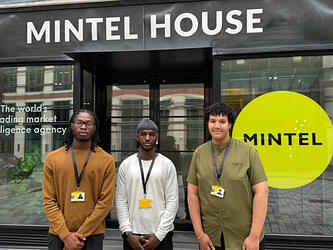Seven core ingredients to creating customer-led transformation

The first two ingredients are, perhaps, the most important, in that they are things that all of us need to consider in any design of a customer insight programme or project: how to build awareness and understanding – the winning of hearts and minds – and ensuring we influence decisions across the organisation, not just focussing on the ‘top table’:
- Build awareness and understanding
Every programme needs to win hearts and minds if it is to influence action. It is central to our purpose, that we communicate and amplify the voice of customers across the organisation. To do that we must think about the existing communications channels in the organisation. There might be existing channels that can be leveraged, such as intranets, events or social spaces or regular meetings like Operational Board meetings or company-wide newsletters.
There might also be a need to create new insight brand and collateral to help communicate different streams of insight. These can help elevate specific things like a newsletter or help advertise ‘drop-in’ clinics or Town Hall type events.
- Operate at different levels
The second ingredient that we should always be thinking about is how to influence all decisions, not just a handful. To achieve this, we must move away from a mindset that solely focusses on ‘having a seat at the top table’ and having a ‘seat at many tables’. Yes, the top table certainly needs to be a key sponsor and ally to have true influence, but customer-decisions are mostly made elsewhere in an organisation. Customer-think needs to operate at all levels.
We need to make sure that we have a strategy for each of these and running a ‘decision audit’ is an important way to help identify where customer-focussed decisions are being made, the key influencers and champions and ways we -and they – can help build awareness and which communication strategies will help feed customer-thinking into every place where customer-facing decisions get made.
A decision audit is, essentially, a process of reviewing or surveying stakeholders across different divisions and departments. This needs to review the types of decisions they influence, the way those are made, the customer data they already have (and use or don’t use), the customer insight they would like to have, their communications styles and skill levels in handing and using data. A good decision audit will help challenge our thinking and give us the starting blocks to build our transformation programme on.
Once we have conducted our decision-audit we will also be ready to build in the next four ingredients into our customer programme:
- Break departmental silos
One of the major barriers to organisations to using customer insight effectively during decision-making is the way the organisation is structured. More often than not organisational charts have linear hierarchies and departments and teams that are super-focussed on executing a specific function or process. This is what effective operational processes need. However, they can also be barriers to creating customer-centric thinking and because they create siloed thinking and ‘tunnel vision’.
For customer-led transformation to really work, it must work across the organisation, linking different teams to different insights. We must, therefore, spend time designing our programme so that it is influencing all departments and teams. The decision audit will help identify which data and insight points are needed in each department and which data points those teams already collect but might not share. It needs to outline the way each make decisions, the way they prefer to communicate and want to consume data.
- Draw-in other data points
One thing which, hopefully, comes out of the audit is that there are already lots of data points and ways that the customer voice can be heard, already, in the organisation. The role of a good Customer Transformation programme is to bring all of that data into play and to facilitate its use and exchange. Our role isn’t just to create new data but to operate in a two-way manner so that we can help also collect and share data already in use, bringing back into different parts of the organisation. A key ingredient of a successful programme is that it identifies different data available, blends it with other data points and create ways for that to be shared or streamed into other departments, curating a better understanding of the customer.
- Identify and build influencers
A successful programme needs champions and influencers. They will help motivate people, amplify the message and engage audiences on our behalf. One use of your stakeholder audit is to understand the needs of different decision-makers and the types of data and insights they need and identify key influencers within an organisation and how best to work with them to help amplify the use of insights and bring customers into more decisions.
- Create opportunities for collaboration
Opportunities for discussion and collaboration are critical for success. A programme only becomes effective at embedding customer-thinking into decisions IF stakeholders can bring to mind key pieces of knowledge at the point they are making a decision. To be able to do that they must, almost, have a level of customer intuition or be able to ‘work a customer muscle’ when they need. And like any muscle or intuition, they must be practiced and ready at those points in time.
Discussion is a key driver to helping people internalise insights and – ultimately – will increase the likelihood that future decisions are influenced by that customer thinking. Practical tips for achieving this include drop-in clinics, Town Halls and Open Mic sessions.
Collaboration can work in different ways; point six helps us think about how we create opportunities for teams and departments to discuss customers and the data and insight we hold, which, in turn, helps decision-makers become comfortable with customer needs and ways our decisions will affect them. But there is also another form of collaboration; collaborating directly with customers themselves, so the final ingredient of the programme should build-in ways for decision-makers to connect with them.
- Build opportunities to connect with customers
The aim of a customer-transformation programme is to rewire the organisation to think more like a customer. To aid this people should be given the opportunity to directly connect or meet or see customers, so they can understand and feel their needs and emotions. We need to bring customers to life, first hand; make them emotional humans not just data points. This can be achieved by creating customer closeness sessions, arranging direct chats with customers, adopting a more immersive approach to project design with accompanied shops or in-home visits.
Customer Salience and Transformation
Customer Salience isn’t just an awareness of customers. It’s the ability for decision-makers to bring customers to mind at the point they make a decision. It is an act of influence; an action. It cannot be passive. Therefore, our customer programme must have ingredients that mix to both build an awareness of what matters to customers but also to help people internalise that understanding so that it becomes second-nature to bring customer needs to mind at any point decisions get made.
This approach changes any normal customer research and insight project from being a passive set of recommendations or discrete data points, into being a verb, an ability to do, to act and decide based on our collective understanding.

We hope you enjoyed this article.
Research Live is published by MRS.
The Market Research Society (MRS) exists to promote and protect the research sector, showcasing how research delivers impact for businesses and government.
Members of MRS enjoy many benefits including tailoured policy guidance, discounts on training and conferences, and access to member-only content.
For example, there's an archive of winning case studies from over a decade of MRS Awards.
Find out more about the benefits of joining MRS here.














0 Comments